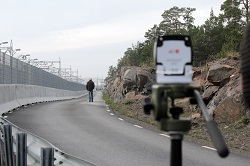Protecting core utilities and services through targeted surveillance
EU-funded researchers have developed a cutting edge proactive surveillance system to protect major infrastructure such as power stations. Integrated elements of the system can communicate with each other and solve complex surveillances tasks collaboratively, ensuring that large areas can be monitored without infringing privacy. ‘We developed this new technology through the P5 project in order to protect critical infrastructure in a more efficient and privacy-aware manner,’ explains David Lindgren, project coordinator at the Swedish Defence Research Agency. ‘We also hope that the new technology will create new business opportunities and employment in Europe. In the future for example, the P5 system could be expanded to include mobile sensors in the form of autonomous drones, in order to give staff great flexibility and the capability to survey large areas with high definition sensory data.’ Intelligent perimeter proactive surveillance systems, like the kind developed in the P5 project, are typically used by critical infrastructures such as power plants, server sites and telecommunication centres to protect against threats such as sabotage and terrorist attacks. They monitor the region outside the security area of critical buildings and infrastructures, and give an early warning if terrestrial or airborne threats are approaching. By alerting staff to possible threats as early as possible, valuable time can be saved to put in place countermeasures such as the closure of facilities and alerting the police. In an attack on a nuclear power plant where radioactive contamination is a very real possibility for example, every second counts in order to shut down operations and evacuate the area. A key challenge however has been ensuring that these surveillance systems work effectively and efficiently over large areas 24 hours a day, whilst at the same time ensuring that only credible threats are spotted and followed. For example false alarms can be triggered by wandering animals, whilst new surveillance technology is constrained by legislation concerning privacy. ‘In order to address these challenges, we developed an autonomous and intelligent surveillance system by the principle of privacy-by-design, where design choices are based on ethical and legal considerations,’ says Lindgren. ‘Experts in ethics and law have been part of the project, and we have different filters in the system for removing sensitive information. If one needs to inspect data later, then permission must be sought from a prosecutor. The end results could lead to a much better balance between efficient surveillance and ensuring privacy in the future.’ The system works by detecting danger automatically with the help of algorithms, and then following potential saboteurs. It then analyses the situation and tries to find movement patterns that might indicate whether something criminal is underway. The P5 system was recently demonstrated at the Centre for Teaching and Research in Disaster Medicine and Traumatology in Linköping, Sweden. Potential interested parties include industries with products and services within security and surveillance segment, as well as operators of large scale infrastructure. The innovations will also likely appeal to government agencies with responsibilities for legislation and security as well as police forces around Europe.







